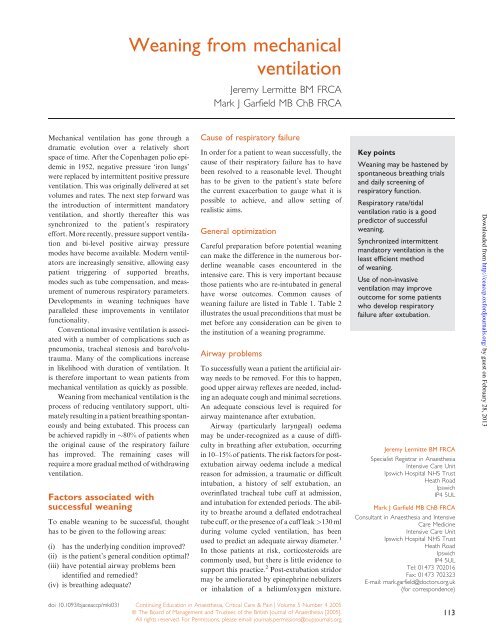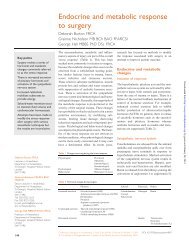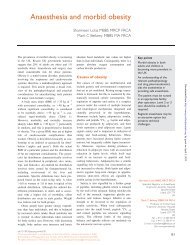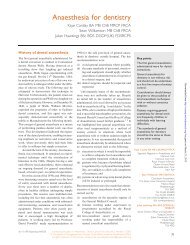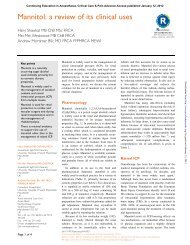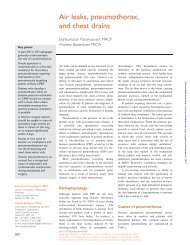Weaning from mechanical ventilation - CEACCP
Weaning from mechanical ventilation - CEACCP
Weaning from mechanical ventilation - CEACCP
Create successful ePaper yourself
Turn your PDF publications into a flip-book with our unique Google optimized e-Paper software.
Mechanical <strong>ventilation</strong> has gone through a<br />
dramatic evolution over a relatively short<br />
space of time. After the Copenhagen polio epidemic<br />
in 1952, negative pressure ‘iron lungs’<br />
were replaced by intermittent positive pressure<br />
<strong>ventilation</strong>. This was originally delivered at set<br />
volumes and rates. The next step forward was<br />
the introduction of intermittent mandatory<br />
<strong>ventilation</strong>, and shortly thereafter this was<br />
synchronized to the patient’s respiratory<br />
effort. More recently, pressure support <strong>ventilation</strong><br />
and bi-level positive airway pressure<br />
modes have become available. Modern ventilators<br />
are increasingly sensitive, allowing easy<br />
patient triggering of supported breaths,<br />
modes such as tube compensation, and measurement<br />
of numerous respiratory parameters.<br />
Developments in weaning techniques have<br />
paralleled these improvements in ventilator<br />
functionality.<br />
Conventional invasive <strong>ventilation</strong> is associated<br />
with a number of complications such as<br />
pneumonia, tracheal stenosis and baro/volutrauma.<br />
Many of the complications increase<br />
in likelihood with duration of <strong>ventilation</strong>. It<br />
is therefore important to wean patients <strong>from</strong><br />
<strong>mechanical</strong> <strong>ventilation</strong> as quickly as possible.<br />
<strong>Weaning</strong> <strong>from</strong> <strong>mechanical</strong> <strong>ventilation</strong> is the<br />
process of reducing ventilatory support, ultimately<br />
resulting in a patient breathing spontaneously<br />
and being extubated. This process can<br />
be achieved rapidly in 80% of patients when<br />
the original cause of the respiratory failure<br />
has improved. The remaining cases will<br />
require a more gradual method of withdrawing<br />
<strong>ventilation</strong>.<br />
Factors associated with<br />
successful weaning<br />
To enable weaning to be successful, thought<br />
has to be given to the following areas:<br />
(i) has the underlying condition improved?<br />
(ii) is the patient’s general condition optimal?<br />
(iii) have potential airway problems been<br />
identified and remedied?<br />
(iv) is breathing adequate?<br />
<strong>Weaning</strong> <strong>from</strong> <strong>mechanical</strong><br />
<strong>ventilation</strong><br />
Jeremy Lermitte BM FRCA<br />
Mark J Garfield MB ChB FRCA<br />
Cause of respiratory failure<br />
In order for a patient to wean successfully, the<br />
cause of their respiratory failure has to have<br />
been resolved to a reasonable level. Thought<br />
has to be given to the patient’s state before<br />
the current exacerbation to gauge what it is<br />
possible to achieve, and allow setting of<br />
realistic aims.<br />
General optimization<br />
Careful preparation before potential weaning<br />
can make the difference in the numerous borderline<br />
weanable cases encountered in the<br />
intensive care. This is very important because<br />
those patients who are re-intubated in general<br />
have worse outcomes. Common causes of<br />
weaning failure are listed in Table 1. Table 2<br />
illustrates the usual preconditions that must be<br />
met before any consideration can be given to<br />
the institution of a weaning programme.<br />
Airway problems<br />
To successfully wean a patient the artificial airway<br />
needs to be removed. For this to happen,<br />
good upper airway reflexes are needed, including<br />
an adequate cough and minimal secretions.<br />
An adequate conscious level is required for<br />
airway maintenance after extubation.<br />
Airway (particularly laryngeal) oedema<br />
may be under-recognized as a cause of difficulty<br />
in breathing after extubation, occurring<br />
in 10–15% of patients. The risk factors for postextubation<br />
airway oedema include a medical<br />
reason for admission, a traumatic or difficult<br />
intubation, a history of self extubation, an<br />
overinflated tracheal tube cuff at admission,<br />
and intubation for extended periods. The ability<br />
to breathe around a deflated endotracheal<br />
tube cuff, or the presence of a cuff leak >130 ml<br />
during volume cycled <strong>ventilation</strong>, has been<br />
used to predict an adequate airway diameter. 1<br />
In those patients at risk, corticosteroids are<br />
commonly used, but there is little evidence to<br />
support this practice. 2 Post-extubation stridor<br />
may be ameliorated by epinephrine nebulizers<br />
or inhalation of a helium/oxygen mixture.<br />
doi 10.1093/bjaceaccp/mki031 Continuing Education in Anaesthesia, Critical Care & Pain | Volume 5 Number 4 2005<br />
ª The Board of Management and Trustees of the British Journal of Anaesthesia [2005].<br />
All rights reserved. For Permissions, please email: journals.permissions@oupjournals.org<br />
Key points<br />
<strong>Weaning</strong> may be hastened by<br />
spontaneous breathing trials<br />
and daily screening of<br />
respiratory function.<br />
Respiratory rate/tidal<br />
<strong>ventilation</strong> ratio is a good<br />
predictor of successful<br />
weaning.<br />
Synchronized intermittent<br />
mandatory <strong>ventilation</strong> is the<br />
least efficient method<br />
of weaning.<br />
Use of non-invasive<br />
<strong>ventilation</strong> may improve<br />
outcome for some patients<br />
who develop respiratory<br />
failure after extubation.<br />
Jeremy Lermitte BM FRCA<br />
Specialist Registrar in Anaesthesia<br />
Intensive Care Unit<br />
Ipswich Hospital NHS Trust<br />
Heath Road<br />
Ipswich<br />
IP4 5UL<br />
Mark J Garfield MB ChB FRCA<br />
Consultant in Anaesthesia and Intensive<br />
Care Medicine<br />
Intensive Care Unit<br />
Ipswich Hospital NHS Trust<br />
Heath Road<br />
Ipswich<br />
IP4 5UL<br />
Tel: 01473 702016<br />
Fax: 01473 702323<br />
E-mail: mark.garfield@doctors.org.uk<br />
(for correspondence)<br />
113<br />
Downloaded <strong>from</strong><br />
http://ceaccp.oxfordjournals.org/ by guest on February 28, 2013
<strong>Weaning</strong> <strong>from</strong> <strong>mechanical</strong> <strong>ventilation</strong><br />
Table 1 Causes of weaning difficulty<br />
Central drive<br />
Drive to breathe reduced by:<br />
Sedatives<br />
Direct insults to the respiratory centre<br />
Hyper<strong>ventilation</strong> to abnormally low PaCO 2 for a particular patient<br />
Metabolic alkalosis (commonly exacerbated by hypokalaemia)<br />
Loss of hypoxic drive (COPD)<br />
Clinically patients may fail to demonstrate respiratory distress and<br />
will in time develop Type II respiratory failure<br />
Neuromuscular<br />
Primary neurological disorders<br />
Guillain–Barré syndrome<br />
Myasthenia Gravis<br />
Botulism<br />
Critical illness polyneuropathy (more common with steroids and<br />
neuromuscular blocking agents)<br />
Critical care myopathy/malnutrition<br />
Electrolyte abnormalities<br />
Hypokalaemia<br />
Hypophosphataemia<br />
Hypomagnesaemia<br />
Hypocalcaemia<br />
Hypothyroidism<br />
Increased respiratory load<br />
Increased resistance<br />
Bronchospasm<br />
Increased or thick secretions<br />
Reduced compliance<br />
Pneumonia<br />
Pulmonary oedema<br />
Intrinsic PEEP<br />
Pleural effusions<br />
Pneumothoraces<br />
Paralytic ileus or abdominal distension<br />
Increased <strong>ventilation</strong><br />
Hypermetabolism (sepsis is a common cause)<br />
Overfeeding<br />
Metabolic acidosis<br />
Shock<br />
Pulmonary embolism<br />
Table 2 General preconditions for commencement of weaning<br />
Reversal of primary problem causing need for <strong>ventilation</strong><br />
Patient awake and responsive<br />
Good analgesia, ability to cough<br />
Reducing or minimal doses of inotropic support<br />
Ideally—functioning bowels, absence of abdominal distension<br />
Normalizing metabolic status<br />
Adequate haemoglobin concentration<br />
Continuous positive airway pressure administered after extubation<br />
may also help.<br />
Predicting successful weaning<br />
Numerous numerical indices have been used to predict the outcome<br />
of weaning, some of which are listed in Table 3. The sensitivities<br />
and specificities of each vary depending upon the cut-off<br />
used. Many of the indices have good sensitivities but most have<br />
low specificities. When looking at these indices, it is not only<br />
important to look at the cut-off used but also the timing as to<br />
when the test was undertaken.<br />
114<br />
Continuing Education in Anaesthesia, Critical Care & Pain | Volume 5 Number 4 2005<br />
Table 3 Numerical indices used to predict successful weaning<br />
Minute <strong>ventilation</strong> 10 ml kg 1<br />
Respiratory frequency 5ml kg 1<br />
Maximum inspiratory pressure < 25 cm H2O<br />
PaO /PAO 2 2<br />
Respiratory rate/tidal volume<br />
>0.35<br />
200 mm Hg (26.3 kPa)<br />
A number of guidelines favour the use of the ratio of respiratory<br />
rate/tidal volume undertaken 1 min into a spontaneous breathing<br />
trial (SBT). 3 In addition, a reasonable level of oxygenation should<br />
be demonstrated, often assessed by the Pa O2 /F I O2 ratio at a positive<br />
end-expiratory pressure (PEEP)
The best trials looking at the weaning of patients that fail their<br />
initial spontaneous breathing trial have given conflicting results.<br />
The ventilatory choices for these patients include the following:<br />
(i) T-piece trials;<br />
(ii) synchronized intermittent mandatory <strong>ventilation</strong> (SIMV); or<br />
(iii) pressure support <strong>ventilation</strong> (PSV).<br />
T-piece trials involve periods of supported <strong>ventilation</strong> being<br />
gradually broken up by SBTs of increasing duration (most trials<br />
increase these durations twice per day). There is some evidence<br />
that once-daily breathing trials may be just as effective. 6 Once the<br />
Table 4 Criteria used in some trials to terminate (fail) SBTs<br />
Respiratory rate >35 bpm<br />
SpO2 140 beats min 1 or change by >20%<br />
Systolic blood pressure >180 or 200, PEEP ≤5, adequate<br />
cough, f/V T
<strong>Weaning</strong> <strong>from</strong> <strong>mechanical</strong> <strong>ventilation</strong><br />
SIMV or bi-level positive airway pressure and a form of PSV.<br />
There is also evidence <strong>from</strong> both trials that protocols may<br />
hasten weaning.<br />
A suggested algorithm for discontinuation of <strong>mechanical</strong><br />
<strong>ventilation</strong> is shown in Figure 1.<br />
Non-invasive <strong>ventilation</strong><br />
Patients who are re-intubated have higher complication and<br />
mortality rates. Non-invasive <strong>ventilation</strong> could not only avoid<br />
intubation in some patients, but may also have a role in preventing<br />
re-intubation in patients who have failed extubation. 8 Patients<br />
with chronic obstructive pulmonary disease (COPD), and those<br />
who are immunosuppressed with bilateral infiltrates, have been<br />
shown to have reduced intubation and mortality rates with the<br />
application of non-invasive <strong>ventilation</strong>. Benefit has also been<br />
demonstrated for patients with cardiogenic pulmonary oedema.<br />
Whether non-invasive <strong>ventilation</strong> has advantages over CPAP has<br />
yet to be proven for this group of patients (one study actually<br />
showed a higher rate of myocardial infarction with use of noninvasive<br />
<strong>ventilation</strong>).<br />
Studies looking at heterogeneous populations with acute<br />
hypoxaemic respiratory failure have found no benefit in using<br />
non-invasive <strong>ventilation</strong> to facilitate the discontinuation of conventional<br />
<strong>ventilation</strong> or avoid re-intubation. Only trials looking at<br />
patients with COPD or cardiogenic pulmonary oedema, or with<br />
a predominance of such patients, have demonstrated improved<br />
survival, decreased pneumonia rates and decreased length of<br />
intensive care stays under these circumstances. 9–11<br />
Tracheostomies<br />
It is a generally held belief, despite the lack of evidence demonstrating<br />
direct benefit, that patients requiring long-term ventilatory<br />
support are better managed using a tracheostomy. Some<br />
of the advantages include easier mouth care, improved mobility<br />
of the patient, facilitation of oral nourishment; improved patient<br />
comfort allowing decreased sedation and better communication.<br />
Decreasing sedation use has been shown to reduce the length of<br />
intensive care stay. In view of these advantages, it would prove<br />
difficult to recruit patients for a trial comparing continued<br />
translaryngeal and tracheostomy routes of ventilatory support.<br />
Surgical and percutaneous tracheostomies have broadly been<br />
shown to carry equal risk. The forthcoming randomized controlled<br />
multi-centre ‘Tracman’ trial is aiming to elucidate whether<br />
there is an advantage to performing tracheostomies at a particular<br />
time. One single centre randomized trial by Rumbak and colleagues,<br />
12 in a medical intensive care unit, demonstrated a reduced<br />
length of stay, reduced mortality and nosocomial pneumonia rate<br />
in the early tracheostomy group.<br />
Patients proving difficult to wean<br />
Equipment problems such as encrustation of the endotracheal<br />
tube or secretions in the filter can influence the ability to wean.<br />
116<br />
The endotracheal tube may itself cause bronchospasm. Obese<br />
patients may require a higher level of PEEP while intubated to<br />
prevent atelectasis. Those with severe restrictive disease may<br />
normally breathe with a high respiratory rate. It may be appropriate<br />
in these sorts of patients to attempt an extubation.<br />
Some patients will not wean quickly and may require the services<br />
of a specialist-weaning unit. These units take a much longerterm<br />
approach to weaning than most acute ICUs, and have a<br />
number of ventilatory modalities at their disposal. In the UK,<br />
they also have access to the resources required to arrange ongoing<br />
<strong>ventilation</strong> in the community, whether invasive or non-invasive.<br />
An example of referral criteria used in a recent study included<br />
<strong>mechanical</strong> <strong>ventilation</strong> for more than 2 weeks, and having failed<br />
two spontaneous breathing trials. Of 403 patients studied, 68%<br />
were successfully weaned <strong>from</strong> the ventilator. The hospital mortality<br />
of those admitted was 25%. Only 50% of those admitted were<br />
alive at 1 yr, and 38% at 3 yr. 13<br />
<strong>Weaning</strong> protocols<br />
It is has been shown in many studies that use of a weaning protocol<br />
reduces time on the ventilator and shortens ICU stay. 14 Much of<br />
this work has been conducted in ‘open’ intensive care units in the<br />
USA, many of which are not run by specialist intensive care physicians.<br />
In these units, where a physician may only see patients once<br />
per day, these nurse-led protocols clearly work. A recent study,<br />
however, compared weaning by protocol with physician-directed<br />
weaning in a ‘closed’ ICU, staffed and directed by ICU-trained<br />
physicians. The results showed no difference between the two<br />
groups of patients with regard to duration of <strong>ventilation</strong>, ICU<br />
stay, hospital and ICU mortality, and re-intubation rate. 15 The<br />
message <strong>from</strong> this study is that it is not the protocol that hastens<br />
weaning, but the constant vigilance and attention that the protocol<br />
necessitates.<br />
Conclusion<br />
All patients receiving ventilatory support should be assessed on a<br />
daily basis for their suitability for weaning. This may involve<br />
meeting several preconditions, and then an SBT. If unsuccessful,<br />
weaning should be attempted using either PSV, or daily spontaneous<br />
breathing periods of increasing duration. A tracheostomy<br />
may be helpful in patients who are difficult to wean. Over 95% of<br />
patients should be weanable in this way. A few patients per year<br />
may need referral to a long-term weaning unit.<br />
References<br />
Continuing Education in Anaesthesia, Critical Care & Pain | Volume 5 Number 4 2005<br />
1. Jaber S, Chanques G, Matecki S, et al. Post-extubation stridor in intensive<br />
care patients. Intensive Care Med 2003; 29: 69–74<br />
2. Ho LI, Harn HJ, Lien TC, Hu PY, Wang JH. Post-extubation laryngeal<br />
edema in adults. Risk factor evaluation and prevention by hydrocortisone.<br />
Intensive Care Med 1996; 22: 933–6<br />
3. Yang KL, Tobin MJ. A prospective study of indexes predicting the outcome<br />
of trials of weaning <strong>from</strong> <strong>mechanical</strong> <strong>ventilation</strong>. N Engl J Med 1991; 324:<br />
1445–50<br />
Downloaded <strong>from</strong><br />
http://ceaccp.oxfordjournals.org/<br />
by guest on February 28, 2013
4. Ely EW, Baker AM, Dunagan DP. Effect on the duration of <strong>mechanical</strong><br />
<strong>ventilation</strong> of identifying patients capable of breathing spontaneously.<br />
N Engl J Med 1996, 335: 1864–9<br />
5. Esteban A, Alia I, Tobin MJ, et al. Effects of spontaneous breathing trial<br />
duration on outcome of attemptstodiscontinue <strong>mechanical</strong> <strong>ventilation</strong>. Am<br />
J Respir Crit Care Med 1999; 159: 512–18<br />
6. Esteban A, Frutos F, Tobin MJ, et al. A comparison of four methods<br />
of weaning patients <strong>from</strong> <strong>mechanical</strong> <strong>ventilation</strong>. N Engl J Med 1995;<br />
332: 345–50<br />
7. Brochard L, Raus A, Benito S, et al. Comparison of three methods<br />
of gradual withdrawal <strong>from</strong> ventilatory support during weaning<br />
<strong>from</strong> <strong>mechanical</strong> <strong>ventilation</strong>. Am J Respir Crit Care Med 1994; 150:<br />
896–903<br />
8. Truwit JD, Bernard GR. Noninvasive <strong>ventilation</strong>–don’t push too hard.<br />
N Engl J Med 2004; 350: 2512–15<br />
9. Nava S, Ambrosino N, Clini E, et al. Noninvasive <strong>mechanical</strong> <strong>ventilation</strong><br />
in the weaning of patients with respiratory failure due to chronic<br />
obstructive pulmonary disease. Ann Intern Med 1998; 128: 721–8<br />
10. Girault C, Daudenthun I, Chevron V, et al. Noninvasive <strong>ventilation</strong><br />
as a systematic extubation and weaning technique in acute on<br />
chronic respiratory failure. Am J Respir Crit Care Med 1999; 160: 86–92<br />
11. Esteban A, Frutos-Vivar M, Ferguson M, Arabi M. Noninvasive<br />
positive-pressure <strong>ventilation</strong> for respiratory failure after extubation.<br />
N Engl J Med 2004; 350: 2452–9<br />
12. Rumbak MJ, Newton M, Truncale T, Schwartz SW, Adams JW, Hazard PB.<br />
A prospective randomized study comparing early percutaneous dilational<br />
tracheotomy to prolonged translaryngeal intubation (delayed tracheotomy)<br />
in critically ill medical patients. Crit Care Med 2004; 32: 1689–94<br />
13. Schonhofer B, Euteneuer S, Nava S, Suchi S, Kohler D. Survival of<br />
<strong>mechanical</strong>ly ventilated patients admitted to a specialised weaning<br />
centre. Intensive Care Med 2002; 27: 908–16<br />
14. Dries DJ, McGonigal MD, Malian MS, Bor BJ, Sullivan C. Protocol-driven<br />
ventilator weaning reduces use of <strong>mechanical</strong> <strong>ventilation</strong>, rate of early<br />
reintubation, and ventilator-associated pneumonia. J Trauma 2004; 56:<br />
943–51<br />
15. Schonhofer B, Euteneuer S, Nava S, Suchi S, Kohler D. A<br />
prospective, controlled trial of a protocol-based strategy to<br />
discontinue <strong>mechanical</strong> <strong>ventilation</strong>. Am J Respir Crit Care Med 2004;<br />
169: 673–8<br />
See multiple choice questions 85–87.<br />
<strong>Weaning</strong> <strong>from</strong> <strong>mechanical</strong> <strong>ventilation</strong><br />
Continuing Education in Anaesthesia, Critical Care & Pain | Volume 5 Number 4 2005 117<br />
Downloaded <strong>from</strong><br />
http://ceaccp.oxfordjournals.org/ by guest on February 28, 2013


